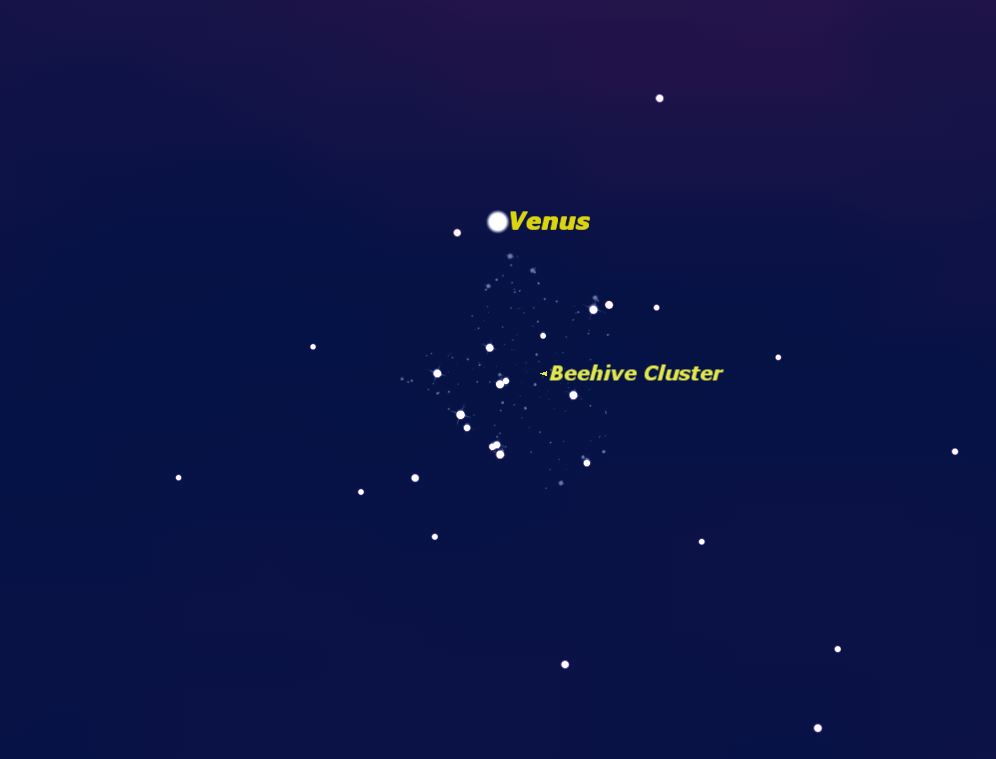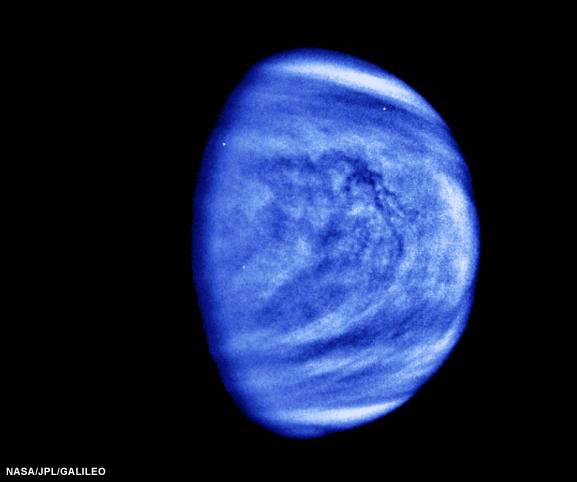See Venus Near Cosmic Beehive Tonight

The planet Venus will have an interesting encounter with a cosmic swarm of bees in the night sky tonight (July 3).
Venus has only recently emerged from behind the sun, so you may not have seen it yet as an "evening star." Tonight it will shine low in the western sky near the Beehive star cluster, weather permitting.
Venus is of course a planet, which shines by light reflected from the sun, and not a star, a huge ball of glowing plasma in the far reaches of space. To the naked eye, stars and planets look the same, so ancient astronomers called them all "stars." [July Night Sky Stargazing Events (Sky Map Guide)]
Venus explained
The ancients did note that some "stars" appeared to move, so gave them a special name, "planets," which means "wandering stars." In particular they noticed that two especially bright planets never wandered very far from the sun.
At first they thought these were two different objects, one in the morning sky, one in the evening, but at some point realized that these were really aspects of the same object, which they named "Venus." The next step was the realization that Venus' movements could be explained by a body revolving in a circle around the sun, peeking out first on one side, then the other.
Venus is still quite close to the sun in the sky, so you will need a low western horizon to catch a glimpse of it as it sets about an hour and a half after the sun. On Wednesday night, use your binoculars to follow it down as it gets closer to the horizon. If you're lucky, you may catch a glimmer of hundreds of tiny stars just below it.
Get the Space.com Newsletter
Breaking space news, the latest updates on rocket launches, skywatching events and more!

A cosmic beehive
These stars are members of one of the closest star clusters to our sun, the Beehive Cluster in the constellation Cancer.
This cluster is located 590 light-years from the sun, only the Hyades and the Pleiades being closer. It contains just over a 1,000 stars, of which about 300 are similar to our sun. At least two of the stars in the cluster are home to alien planets, and we can only imagine how glorious the night sky must be on a planet situated in the middle of a star cluster. In fact, Isaac Asimov has written a famous science fiction story, "Nightfall," set on such a planet.
Because it is readily visible in a dark sky with the unaided eye, the Beehive Cluster is known by different names in different cultures. Its resemblance to a swarm of bees has given it the name "the Beehive."
The star cluster has also been called "Praesepe," Latin for "manger." It is seen as a hay-filled manger surrounded by asses waiting to eat. The nearest stars to it are named Asellus Borealis and Asellus Australis, the Northern Ass and the Southern Ass. Astronomers know it as Messier 44, the 44th object in Charles Messier's famous catalog.
Although the Beehive is easily visible with the naked eye in a night sky, seeing it tonight will be a challenge. Venus is only visible close to sunset, and the sky will not be completely dark and hour and a half later when Venus sets. Besides observing from a location with a low western horizon, use binoculars to follow Venus down towards the horizon. Venus itself should be easy to see, as it’s the brightest object in the night sky after the moon, but the stars of the Beehive will be difficult without binoculars.
Editor's note: If you have an amazing picture of Venus or any other night sky view that you'd like to share for a possible story or image gallery, send photos, comments and your name and location to managing editor Tariq Malik at spacephotos@space.com.
This article was provided to SPACE.com by Starry Night Education, the leader in space science curriculum solutions. Follow Starry Night on Twitter @StarryNightEdu. Follow us @Spacedotcom, Facebook and Google+. Original article on SPACE.com.
Join our Space Forums to keep talking space on the latest missions, night sky and more! And if you have a news tip, correction or comment, let us know at: community@space.com.

Geoff Gaherty was Space.com's Night Sky columnist and in partnership with Starry Night software and a dedicated amateur astronomer who sought to share the wonders of the night sky with the world. Based in Canada, Geoff studied mathematics and physics at McGill University and earned a Ph.D. in anthropology from the University of Toronto, all while pursuing a passion for the night sky and serving as an astronomy communicator. He credited a partial solar eclipse observed in 1946 (at age 5) and his 1957 sighting of the Comet Arend-Roland as a teenager for sparking his interest in amateur astronomy. In 2008, Geoff won the Chant Medal from the Royal Astronomical Society of Canada, an award given to a Canadian amateur astronomer in recognition of their lifetime achievements. Sadly, Geoff passed away July 7, 2016 due to complications from a kidney transplant, but his legacy continues at Starry Night.









